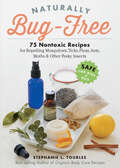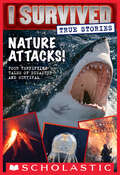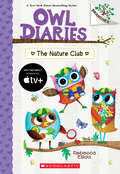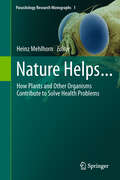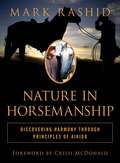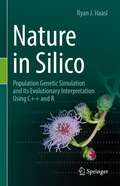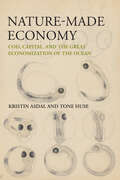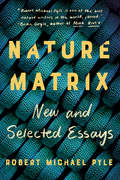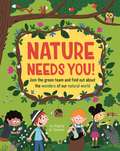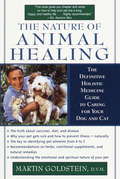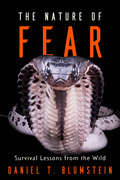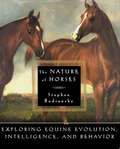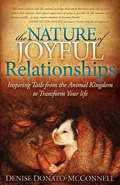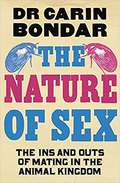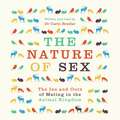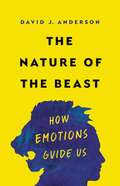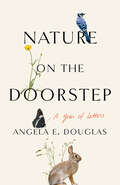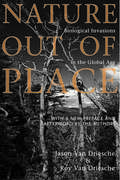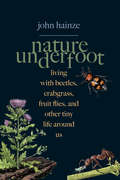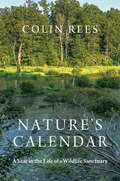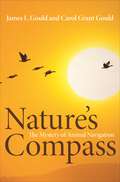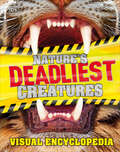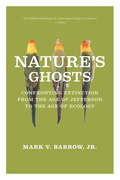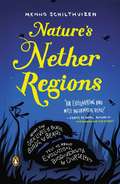- Table View
- List View
Naturally Bug-Free: 75 Nontoxic Recipes for Repelling Mosquitoes, Ticks, Fleas, Ants, Moths & Other Pesky Insects
by Stephanie L. TourlesProtect yourself, your children, your pets, and your home from bugs — without using harsh or toxic chemicals! Herbalist Stephanie Tourles offers 75 simple recipes for safe, effective bug repellents you can make at home from all-natural ingredients. For protection from mosquitos, ticks, and other biting insects, there are sprays, balms, body oils, and tinctures, with scents ranging from eucalyptus to floral, lemon, vanilla, and woodsy spice. There are also recipes for pets, such as herbal shampoo, bedding formulas, and flea-and-tick collars and powders. And Tourles includes repellents for the home, such as sachets that repel moths, carpet powders that repel fleas and ants, and essential oil repellents to keep your pantry pest-free. A detailed ingredient dictionary explains the properties of all the herbs, essential oils, and other key ingredients.
Nature Attacks! (I Survived True Stories #2)
by Lauren TarshisFrom the author of the New York Times-bestselling I Survived series come four harrowing true stories of survival, featuring real kids in the midst of epic disasters.REAL KIDS. REAL DISASTERS.The author of the New York Times-bestselling I Survived series brings us more harrowing true stories of real kids up against terrible forces of nature. From fourteen-year-old lone survivor of the shark attacks of 1916, to nine-year-old who survived the Peshtigo fire of 1871 (which took place on the very same day in history as the Great Chicago Fire!), here are four unforgettable survivors who managed to beat the odds.Read their incredible stories:The Deadly Shark Attacks of 1916The Great Peshtigo Fire of 1871A Venomous Box Jellyfish AttackThe Eruption of Mount Tambora
The Nature Club: A Branches Book (Owl Diaries)
by Rebecca ElliottIn the next installment of this New York Times bestselling early chapter book series, Eva wants to help the planet!Pick a book. Grow a Reader!This series is part of Scholastic's early chapter book line, Branches, aimed at newly independent readers. With easy-to-read text, high-interest content, fast-paced plots, and illustrations on every page, these books will boost reading confidence and stamina. Branches books help readers grow!Eva’s class is preparing for the Nature Day party. Mrs. Featherbottom splits the class into two clubs and each club has to come up with ways to help the planet. When Eva gets placed in a different club from her best friends, Lucy and Hailey, she misses them. But Eva learns new things about her classmates, and she discovers that someone in her club is also missing a friend!With speech bubbles, easy-to-read text, and adorable characters, this New York Times bestselling series is perfect for newly independent readers!Continue this book series with “Eva the Owlet,” an Apple TV+ original series!
Nature Helps...
by Heinz MehlhornNature helps... of course at first itself by developing measures that give bacteria, fungi, plants and animals a chance to be successful in their struggle for life. As a latecomer on Earth, Homo sapiens was gifted with some droplets of the divine spirit of recognition and thus became able to observe, to analyse and recombine skills of other living beings and to use them for his overwhelming career over the last 10,000 years. Of course fungi, plants, animals and even bacteria were primarily used by mankind as food or as lifestyle products such as beer, but soon it became clear that there was much more potential hidden in these organisms and that they could be used for other purposes, too. Extracts of plants and fungi were recognized as powerful remedies, as medicines, as insecticides or acarizides, as repellents against parasites or even as weapons, e.g. when poisonous compounds from frogs or plants were applied to arrowheads. Over the last 110 years the pharmaceutical industry has often simulated nature by analyzing complex organic substances taken from living organisms and then producing by synthesis absolutely pure compounds, which mostly consisted of only one single active substance. These products had the advantage of acting against precisely one target and thus produced fewer possible side effects than the complex plant extracts. However, the more serious side effect was that disease agents could develop resistances to pure medicinal products much more easily. Thus after 70 years of excellent prospects for chemotherapy, some dark clouds appeared and quickly gathered, so that several therapeutic remedies now no longer work. Therefore in many countries - especially in those where the pure chemotherapeutics are too expensive for the poor population - the cry "back to nature" is becoming louder and louder. This has led to an enormous increase of studies that again use natural extracts as remedies in the fight against diseases. The present book summarizes examples of promising aspects in a broad spectrum of applications and shows how extracts derived from bacteria, marine organisms, plants or even animals may help to treat infectious diseases, how such organisms may keep away parasites and pests from the bodies of plants or animals, including humans, and how they can be used directly to aid in diagnosis, promote wound healing and even to help catch criminals. These 15 chapters offer not only basic research on these different fields, but also show how useful and effective products can be developed from research.
Nature in Horsemanship: Discovering Harmony Through Principles of Aikido
by Mark Rashid Crissi McdonaldThe popular and highly respected horse trainer Mark Rashid brings together Western and Eastern philosophies to demonstrate a seamless new incarnation of horse training. After years of helping OC difficultOCO horses, Mark Rashid understands how to build the foundation of a horseOCOs training and resolve any problems encountered along the way. He explains how he allows the traditionally firm or assertive approach of the old Western style to take some lessons from the softer conflict resolution and ego reduction approach that the Japanese martial art of aikido teaches. RashidOCOs ultimate goal is for harmony between horse and rider. "
Nature in Silico: Population Genetic Simulation and its Evolutionary Interpretation Using C++ and R
by Ryan J. HaaslDramatic advances in computing power enable simulation of DNA sequences generated by complex microevolutionary scenarios that include mutation, population structure, natural selection, meiotic recombination, demographic change, and explicit spatial geographies. Although retrospective, coalescent simulation is computationally efficient—and covered here—the primary focus of this book is forward-in-time simulation, which frees us to simulate a wider variety of realistic microevolutionary models. The book walks the reader through the development of a forward-in-time evolutionary simulator dubbed FORward Time simUlatioN Application (FORTUNA). The capacity of FORTUNA grows with each chapter through the addition of a new evolutionary factor to its code. Each chapter also reviews the relevant theory and links simulation results to key evolutionary insights. The book addresses visualization of results through development of R code and reference to more than 100 figures. All code discussed in the book is freely available, which the reader may use directly or modify to better suit his or her own research needs. Advanced undergraduate students, graduate students, and professional researchers will all benefit from this introduction to the increasingly important skill of population genetic simulation.
Nature-Made Economy: Cod, Capital, and the Great Economization of the Ocean
by Kristin Asdal Tone HuseAn exploration of the economization of the ocean through the small modifications that enable great transformations of nature.The ocean is the site of an ongoing transformation that is aimed at creating new economic opportunities and prosperity. In Nature-Made Economy, Kristin Asdal and Tone Huse explore how the ocean has been harnessed to become a space of capital investment and innovation, and how living nature is wrested into the economy even as nature, in turn, resists, adapts to, or changes the economy. The authors&’ innovative methodological and conceptual approaches examine the economy by focusing on surprising and numerous &“little tools&”—such as maps and policy documents, quality patrols, and dietary requirements for the enhancement of species&’ biological propensities—that value, direct, reorder, accomplish, and sometimes fail to serve our ends, but also add up to great change.Throughout Nature-Made Economy, Asdal and Huse follow one species, the Atlantic cod, and explore how it is subjected to different versions of economization. Taking this species as a point of departure, they then provide novel analyses of the innovation economy, the architecture of markets, the settling of prices, and more, revealing how the ocean is rendered a space of intense economic exploitation. Through their analysis, the authors develop a distinct theoretical approach and conceptual vocabulary for studying nature–economy relations.Nature-Made Economy is a significant contribution to the broad field of STS and social studies of markets, as well as to studies of the Anthropocene, the environment, and human–animal relations.
Nature Matrix: New and Selected Essays
by Robert Michael PyleNature Matrix is a gathering of some of Robert Michael Pyle’s most significant, original, and timely expressions of a life immersed in the natural world, in all its splendor, power, and perilNature Matrix: New and Selected Essays contains sixteen pieces that encompass the philosophy, ethic, and aesthetic of Robert Michael Pyle. The essays range from Pyle’s experience as a young national park ranger in the Sierra Nevada to the streets of Manhattan; from the suburban jungle to the tangles of the written word; and from the phenomenon of Bigfoot to that of the Big Year—a personal exercise in extreme birding and butterflying. They include deep profiles of John Jacob Astor I and Vladimir Nabokov, as well as excursions into wild places with teachers, children, and writers.The nature of real wilderness in modern times comes under Pyle’s lens, as does reconsideration of his trademark concept, “the extinction of experience”—maybe the greatest threat of alienation from the living world that we face today.Nature Matrix shows a way back toward possible integration with the world, as it plumbs the range and depth of experience in one lucky life lived in close connection to the physical earth and its denizens. This collection brings together the thoughts and hopes of one of our most widely read and respected natural philosophers as he seeks to summarize a life devoted to conservation.
Nature Needs You!: Join the Green Team and find out about the wonders of our natural world
by Liz GogerlyFour friends, Anjali, Lulu, Mason and Noah, discover an injured fox in the garden and need to take it to an animal rescue centre. There, they begin a year of discovery learning about the amazing animals, plants and places that make up our natural world.As the year goes on the children talk to lots of different people, from park rangers and environmentalists, to teachers and grandparents. They learn lots of things about the natural world, from biodiversity, food chains and climate change to pollination, plastic pollution and ecosystems.Throughout there are 'Take Action' advice panels, which give examples of small ways that people can get involved to help protect nature.Get Busy activity suggestions encourage children to be actively engaged with nature, by birdwatching or planting wild flowers.There are also full-page, step-by-step activities for how to make a bug hotel and a bird feeder.By the end of the book, readers will have a better understanding of the importance of nature, humans impact on nature and what can be done to help protect itLook out for the other titles in this series: Go Green, Wild Weather and Save our Seas.
The Nature of Animal Healing: The Definitive Holistic Medicine Guide to Caring for Your Dog and Cat
by Martin GoldsteinGoldstein (D. V. M. , Cornell U. College of Veterinary Medicine) espouses a holistic approach to pet care and argues that conventional methods can cause or complicate ill health in pets. Writing primarily for the concerned pet owner, he offers alternatives to commercial pet foods and presents examples of various symptoms he's successfully treated with holistic methods. The book includes an extensive annotated resource guide that comprises listings of product manufacturers as well as excerpts from Helen McKinnon's book citing printed materials, web sites, associations, and veterinarians sympathetic to the cause. Annotation c. Book News, Inc. , Portland, OR (booknews. com)
The Nature of Fear: Survival Lessons From The Wild
by Daniel T. BlumsteinA leading expert in animal behavior takes us into the wild to better understand and manage our fears.Fear, honed by millions of years of natural selection, kept our ancestors alive. Whether by slithering away, curling up in a ball, or standing still in the presence of a predator, humans and other animals have evolved complex behaviors in order to survive the hazards the world presents. But, despite our evolutionary endurance, we still have much to learn about how to manage our response to danger.For more than thirty years, Daniel Blumstein has been studying animals’ fear responses. His observations lead to a firm conclusion: fear preserves security, but at great cost. A foraging flock of birds expends valuable energy by quickly taking flight when a raptor appears. And though the birds might successfully escape, they leave their food source behind. Giant clams protect their valuable tissue by retracting their mantles and closing their shells when a shadow passes overhead, but then they are unable to photosynthesize, losing the capacity to grow. Among humans, fear is often an understandable and justifiable response to sources of threat, but it can exact a high toll on health and productivity.Delving into the evolutionary origins and ecological contexts of fear across species, The Nature of Fear considers what we can learn from our fellow animals—from successes and failures. By observing how animals leverage alarm to their advantage, we can develop new strategies for facing risks without panic.
The Nature of Horses: Exploring Equine Evolution, Intelligence, and Behavior
by Stephen BudianskyA scientific look at the origins, behavior, intelligence and language of the horse, based on cutting-edge research on horses' vision, biology and movement. Horses have a shared history with man going back millennia to their domestication around 4000 B. C. Yet only in very recent years have scientists begun to turn the tools of modern science on this remarkable animal that has been so wrapped up in human dreams and legends. Now modern scientific research is beginning to explain long-standing mysteries about the true nature of the horse. How well can horses really see? What causes breakdowns in racehorses? How intelligent are they compared to other animals, and are some breeds smarter than others? Does nature or nurture matter more in creating a great sport horse? What causes cribbing and other vices? In this beautifully illustrated, compelling narrative, Budiansky tells the story of the origins, behavior, intelligence and language of the horse. For the first time, horse lovers will have access to cutting-edge research on topics of interest including new information on horse vision, horse biology and movement. Introducing the latest archeological findings, Budiansky presents a fascinating discussion of how the horse evolved as well as a dramatic and provocative history of man's use and abuse of the horse from prehistoric times to today. In a revealing chapter on horse intelligence, he debunks the commonly held belief that horses are stupid and also presents compelling new scientific information on horse language which will greatly benefit the horse rider and trainer. Finally, drawing together the latest research on horse physiology, genetics and biomechanics, Budiansky asks the million dollar question -- what makes for a winning racehorse? Anyone who loves horses will find this an invaluable resource as well as a fascinating read.
The Nature of Joyful Relationships: Inspiring Tails from the Animal Kingdom to Transform Your Life
by Denise Donato-McConnellHave you ever asked yourself any of these questions? Am I creating my relationships from a place of love and compassion? Isn't it just part of our animal nature to react with fear and anger? How do I change my perspective to create the healthy, joyful relationships I so desire? The author found answers in what may seem an unlikely group of teachers:
The Nature of Sex: The Ins and Outs of Mating in the Animal Kingdom
by Carin BondarThought about sex today? Of course you have! It's about the most natural thing any animal can do. But have you ever wondered how human sex compares to that of other beasts? It's far from merely inserting part A into slot B. The sex lives of our animal cousins are fiendishly difficult, infinitely varied and often violent. They involve razor-sharp penises, murderous cannibals and chemical warfare in an epic battle between the sexes.Join renowned biologist Dr Carin Bondar on a fascinating journey from puberty to old age across the entire animal kingdom - it will forever change your idle daydreams about the nature of sex.
The Nature of Sex: The Ins and Outs of Mating in the Animal Kingdom
by Dr Carin BondarThought about sex today? Of course you have! It's about the most natural thing any animal can do. But have you ever wondered how human sex compares to that of other beasts? It's far from merely inserting part A into slot B. The sex lives of our animal cousins are fiendishly difficult, infinitely varied and often violent. They involve razor-sharp penises, murderous cannibals and chemical warfare in an epic battle between the sexes.Join renowned biologist Dr Carin Bondar on a fascinating journey from puberty to old age across the entire animal kingdom - it will forever change your idle daydreams about the nature of sex.
The Nature of Sex: The Ins and Outs of Mating in the Animal Kingdom
by Dr Carin BondarNarrated by the author.Thought about sex today? Of course you have! It's about the most natural thing any animal can do. But have you ever wondered how human sex compares to that of other beasts? It's far from merely inserting part A into slot B. The sex lives of our animal cousins are fiendishly difficult, infinitely varied and often violent. They involve razor sharp penises, murderous cannibals and chemical warfare in an epic battle between the sexes.Like us, animals must first find the perfect partner. You think we have it tough? Try having to do it while being hunted down by predators, against a backdrop of unpredictable or life-threatening conditions. Then, sperm and egg must successfully meet. Can you imagine doing this when your partner is intent on killing you or when other disgruntled singles are determined to throw you off your game? The next task is to ensure that the resultant offspring reach sexual maturity in order to keep the cycle going. The myriad ways in which this is accomplished is ingenious.Join Carin Bondar on a fascinating journey from puberty to old age across the entire animal kingdom - it will forever change your idle daydreams about the nature of sex.(p) 2015 Orion Publishing Group
The Nature of the Beast: How Emotions Guide Us
by David J. AndersonA pioneering neuroscientist offers a new way of understanding how emotions drive behaviorDoes your dog get sad when you leave for the day? Does your cat purr because she loves you? Do bears attack when they&’re angry? You can&’t very well ask them. In fact, scientists haven&’t been able to reach a consensus on whether animals even have emotions like humans do, let alone how to study them. Yet studies of animal emotion are critical for understanding human emotion and mental illness. In The Nature of the Beast, pioneering neuroscientist David J. Anderson describes a new approach to solving this problem. He and his colleagues have figured out how to study the brain activity of animals as they navigate real-life scenarios, like fleeing a predator or competing for a mate. His research has revolutionized what we know about animal fear and aggression. Here, he explains what studying emotions and related internal brain states in animals can teach us about human behavior, offering new insights into why isolation makes us more aggressive, how sex and violence connect, and whether there&’s a link between aggression and mental illness. Full of fascinating stories, The Nature of the Beast reconceptualizes how the brain regulates emotions–and explains why we have them at all.
Nature on the Doorstep: A Year of Letters
by Angela E. DouglasNature on the Doorstep reveals the simple pleasures of paying attention to the natural world in one's own backyard over the course of a year. In weekly letters, Angela Douglas shares the joys and curiosities of a decidedly ordinary patch of green in upstate New York cultivated through the art of "strategic neglect"—sometimes taking a hand to manage wildlife, more often letting nature go its own way. From the first flowers of spring to cardinals singing in the winter, Douglas shows us the magic of welcoming unexpected plant and animal life into one's backyard. A paean to the richness we find when we stop to look and let be, Nature on the Doorstep celebrates the role humble backyards play both in conservation efforts and in an expanded appreciation of the living world.
Nature Out of Place: Biological Invasions In The Global Age
by Jason Van Driesche Roy Van DriescheThough the forests are still green and the lakes full of water, an unending stream of invasions is changing many ecosystems around the world from productive, tightly integrated webs of native species to loose assemblages of stressed native species and aggressive invaders. The earth is becoming what author David Quammen has called a "planet of weeds." Nature Out of Place brings this devastating but overlooked crisis to the forefront of public consciousness by offering a fascinating exploration of its causes and consequences, along with a thoughtful and practical consideration of what can be done about it. The father and son team of Jason and Roy Van Driesche offer a unique combination of narratives that highlight specific locations and problems along with comprehensive explanations of the underlying scientific and policy issues.Chapters examine Hawaii, where introduced feral pigs are destroying the islands' native forests; zebra mussel invasion in the rivers of Ohio; the decades-long effort to eradicate an invasive weed on the Great Plains; and a story about the restoration of both ecological and human history in an urban natural area. In-depth background chapters explain topics ranging from how ecosystems become diverse, to the characteristics of effective invaders, to procedures and policies that can help prevent future invasions. The book ends with a number of specific suggestions for ways that individuals can help reduce the impacts of invasive species, and offers resources for further information.By bringing the problem of invasive species to life for readers at all levels, Nature Out of Place will play an essential role in the vital effort to raise public awareness of this ongoing ecological crisis.
Nature Underfoot: Living with Beetles, Crabgrass, Fruit Flies, and Other Tiny Life Around Us
by John HainzeAn informed and heartfelt tribute to commonly unappreciated plants, insects, and other tiny creatures that reconsiders humanity&’s relationship to nature Fruit flies, silverfish, dandelions, and crabgrass are the bane of many people and the target of numerous chemical and physical eradication efforts. In this compelling reassessment of the relationship between humans and the natural world, John Hainze—an entomologist and former pesticide developer—considers the fascinating and bizarre history of how these so-called invasive or unwanted pests and weeds have coevolved with humanity and highlights the benefits of a greater respect and moral consideration toward these organisms. With deep insight into the lives of the underappreciated and often reviled creatures that surround us, Hainze&’s accessible and engaging natural history draws on ethics, religion, and philosophy as he passionately argues that creepy crawlies and unwanted plants deserve both empathy and accommodation as partners dwelling with us on earth.
Nature's Calendar: A Year in the Life of a Wildlife Sanctuary
by Colin ReesTake an enchanting journey through the shifting seasons in a wildlife sanctuary home to wetland, forest, and grassland and supporting an incredible diversity of plants and animals.Flocks of waterfowl exploding into steely skies above frozen marshland, salamanders creeping across the forest floor to vernal pools, chorusing frogs peeping their ecstasy while warblers crowd budding trees, turtles sunning on floating logs, the ecological engineering of beavers—these are but a few of the sights and sounds marking a year at Jug Bay Wetlands Sanctuary and its neighboring landscapes in Southern Maryland. In an absorbing account of a year in the life of this sanctuary, naturalist Colin Rees invites us to join him as he explores the secrets and wonders of the changing natural world. Alongside the author, we witness spring's avian migrations, quickening of aquatic vegetation, burgeoning of myriad invertebrates, and the assaults of extreme weather conditions. We revel in summertime's proliferation of fish, fowl, and mammals. We become attuned to the shifting climate's impacts on autumnal transitions, and we marvel at amazing feats of biological inventiveness in preparation for winter conditions. Through these visions of the fleeting—and yet enduring—cycles of nature, Rees shares deep insights into the ecological and behavioral dynamics of the natural environment. Enhanced by more than two dozen color plates, the book touches on a wide range of issues, from microbial diversity, bird banding, and butterfly phenology to genetic diversity and habitat fragmentation. It also examines the challenges of conserving these and other natural features in the face of climate change and development pressures. Thoughtful and lyrical, Nature's Calendar speaks to all readers, scientific and lay alike. Fascinating profiles of flora and fauna celebrate the richness and complexity of a unique ecosystem, exploring the entire ecology of this dynamic and delicate area.
Nature's Compass: The Mystery of Animal Navigation (Science Essentials #16)
by James L. Gould Carol Grant GouldThe mysterious and remarkable ways that animals navigateWe know that animals cross miles of water, land, and sky with pinpoint precision on a daily basis. But it is only in recent years that scientists have learned how these astounding feats of navigation are actually accomplished. With colorful and thorough detail, Nature's Compass explores the remarkable methods by which animals find their way both near home and around the globe. Noted biologist James Gould and popular science writer Carol Gould delve into the elegant strategies and fail-safe backup systems, the invisible sensitivities and mysterious forces, and incredible mental abilities used by familiar and rare species, as they investigate a multitude of navigation strategies, from the simple to the astonishing.The Goulds discuss how animals navigate, without instruments and training, at a level far beyond human talents. They explain how animals measure time and show how the fragile monarch butterfly employs an internal clock, calendar, compass, and map to commence and measure the two-thousand-mile annual journey to Mexico—all with a brain that weighs only a few thousandths of an ounce. They look at honey bees and how they rely on the sun and mental maps to locate landmarks such as nests and flowers. And they examine whether long-distance migrants, such as the homing pigeon, depend on a global positioning system to let them know where they are. Ultimately, the authors ask if the disruption of migratory paths through habitat destruction and global warming is affecting and endangering animal species.Providing a comprehensive picture of animal navigation and migration, Nature's Compass decodes the mysteries of this extraordinary aspect of natural behavior.
Nature's Deadliest Creatures Visual Encyclopedia (DK Children's Visual Encyclopedias)
by DKCome face-to-face with 150 of the world's scariest killer creatures, from the lion and great white shark to the tarantula, anaconda snake, golden eagle, vampire bat, and even the fierce ant!The book profiles every kind of animal--mammals, reptiles, birds, fish, insects, and arachnids. Chapters are arranged according to how these dangerous predators kill. Do they use jaws and claws, venom, stings, traps, tricks and cunning, or mass invasion?With more than 200 spectacular photos in the book, every page has a stunning image of the animal in action, with data files giving a visual guide to its size, distribution, diet, and habitat, as well as a rating of its "scare factor."Each profile features bite-size text that will appeal to all readers. Discover key facts about how the animal lives (is it solitary or a pack animal?), intriguing anatomy (the platypus is famously one of the few venomous mammals, but did you know that the venom comes from the hind leg on the males only?), and of course, their method of attack (such as chasing prey to exhaustion, launching an ambush, or paralyzing with poison).Further fascinating facts can also be found in the reference section at the end of book, including deadly defense, family trees, toxins, and prehistoric deadly creatures that are no more.
Nature's Ghosts: Confronting Extinction from the Age of Jefferson to the Age of Ecology
by Mark V. Barrow Jr.A historical narrative of endangered animals and the dedicated individuals who have studied and struggled to protect them, offering an unprecedented view of what we've lost and a stark reminder of the hard work of preservation still ahead.
Nature's Nether Regions
by Menno SchilthuizenA tour of evolution's most inventive--and essential--creations: animal genitaliaForget opposable thumbs and canine teeth: the largest anatomical differences between humans and chimps are found below the belt. In Nature's Nether Regions, ecologist and evolutionary biologist Menno Schilthuizen invites readers to discover the wondrous diversity of animalian reproductive organs. Schilthuizen packs this delightful read with astonishing scientific insights while maintaining an absorbing narrative style reminiscent of Mary Roach and Jerry Coyne. With illustrations throughout and vivid field anecdotes--among them laser surgery on a fruit fly's privates and a snail orgy--Nature's Nether Regions is a celebration of life in all shapes and sizes. understand our own unique place in the great diversity of life.
